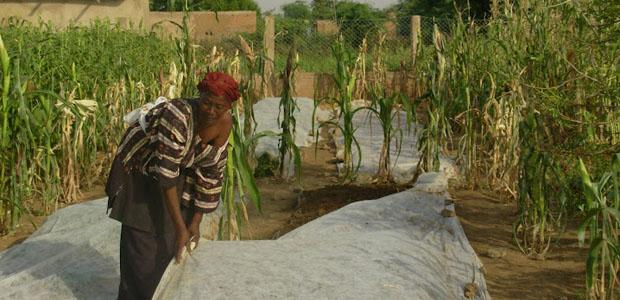Eco-Farming Fosters Better Relations in Senegal
Mauritanian refugee Pele Diaw tends to her new vegetable crops. (Photo: Amanda Fortier)
The meandering Senegal River basin a few hundred kilometers inland from the Atlantic Ocean is a stretch of Africa so dry and desolate that the ground cracks beneath your feet when you walk on it. So it can be a bit of a shock here in the Fouta Toro region to suddenly see a patch of bright green land.
But here it is–row upon row of delicate blossoms of red and white hibiscus, leafy corn stalks and buckets filled high with okra, among other crops, which local resident Mariema Niang names in a broken mix of French and Pulaar, her local language: tomate, carrote, batance, aubergine.
The plot of land is what’s known as a super vegetable garden, or SVG. It’s part of a three year-old experiment in intensive, small-scale farming tended by 100 local women. Niang and most of the others are Mauritanian refugees who fled ethnic violence in their own country more than 20 years ago. The rest are local Senegalese.
The project is run jointly by the United Nations Refugee Agency and a small French development firm called JTS Seeds. The company’s Senegal’s director Moda Gueye says each garden can grow up to five times more produce than traditional local methods, using very little land — more than 1,500 pounds a year on a little more than half an acre.
Each SVG project begins with a selection of seeds and organic soil conditioners and fertilizers. But Gueye says the real key is making the most of the region’s scarcest commodity–water.
Traditionally, farmers here grow only during the short rainy season, and they typically rely on peanuts and millet, which compact the soil and don’t let water seep through. Gueye says the SVG approach includes more varied crops and uses veils and tarps to help hold water and protect the soil from bugs. A small drip irrigation system draws water from the river. Together, Gueye says, these tools allow people to farm year-round while reducing average water use by three-quarters.
The super vegetable gardens project is meant to help solve two deeply linked problems here in northeastern Senegal–food and economic insecurity, and low-level hostility between the Mauritanian refugees and local Senegalese. For years after they arrived, both the refugees and the Senegalese were having trouble making ends meet and getting enough to eat, which inevitably led to tensions.
Refugee Mariema Niang says the farming project has changed that. She says project members have more food and more variety in their diets, and they even have surplus produce to sell, bringing in badly-needed cash. Even better, Niang says, the project has improved relations between the refugees and the locals.
A couple of hundred kilometers east along the river valley, iron gates open onto another group of SVG plots at the Hamady Ounaré refugee camp. Inside, about 50 Mauritanian and Senegalese women set to work with babies on their backs, hoes and shovels over their shoulders, and large plastic buckets and watering cans balanced on their veiled heads.
Forty-eight year old Mauritanian refugee and former hairdresser Habi Barro leads the team.
She says she and her neighbors had worked this plot for 18 years before the super vegetable project arrived. Those farming efforts were killing the land, she says, so they were skeptical about the new approach. But she says they soon realized this project would be different.
Moda Gueye, of JTS Senegal, says the shift came with the very first harvest. He says in that first harvest, the women brought in 200 kilograms of cucumbers and 300 kilograms of okra. Now, Gueye says, the farms here are the most successful in the area.
Shortly before sunset at Hamady Ounaré, the women and children gather round team leader Habi Barro. In a gesture that might have been unheard of here not long ago, one of her Senegalese neighbors says she is so happy with the farming project she wants to sing. Then, with plows and shovels in hand, the Senegalese and Mauritania women begin singing and dancing together.
The UN refugee agency hopes to help set up another 200 to 300 super vegetable gardens here this year, which it says could directly benefit another couple of thousand people. For now the agency is carrying the roughly $700 start-up cost of each farm, but there are plans for a local NGO to start providing micro-loans to help keep the projects going when the UN leaves.
Our coverage reaches millions each week, but only a small fraction of listeners contribute to sustain our program. We still need 224 more people to donate $100 or $10/monthly to unlock our $67,000 match. Will you help us get there today?
